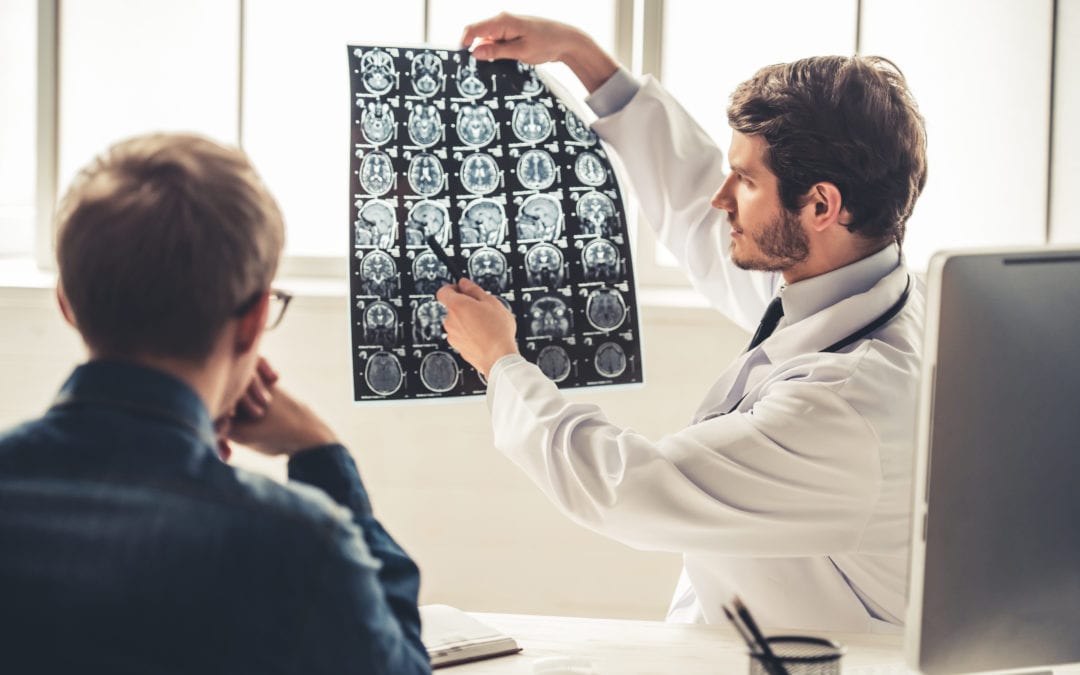Acting quickly when someone is having a stroke can make a big difference. Prompt emergency can help to reduce the risk of long-term disability or death, so learning the signs and symptoms can help prepare you to take the immediate action needed to minimize the negative impact of a stroke. Knowing when to call 911 can save the life of a stroke victim, whether it is your own life or the life of someone else.
What is a Stroke?
A stroke occurs when blood flow to the brain is disrupted. Without adequate blood flow, the brain cells begin to die in that area and the whole body can be affected. There are two main types of stroke: an ischemic stroke is due to blockage of an artery and a hemorrhagic stroke is caused by a blood vessel rupture. A transient ischemic attack, or mini stroke, is a temporary blockage in an artery. They increase your risk for stroke, but don’t usually cause permanent damage themselves. Stroke is a leading cause of death and long-term disability in the United States, so recognizing the signs and symptoms and knowing how to respond is important.
Signs and Symptoms
When learning the signs and symptoms for stroke, it is helpful to remember to act FAST:
- F – Face drooping: Is the face drooping or numb on one side? Ask the person to smile and look to see if their smile appears uneven or lopsided.
- A – Arm weakness: Is one of the arms numb or weak? Ask the person to lift both arms and watch to see if one arm drifts downward.
- S – Speech difficulty: Is the person’s speech slurred, strange or hard to understand? Ask them to repeat a simple sentence such as “the sky is blue” and listen to whether they can repeat the words correctly.
- T – Time to call 911: If someone shows any of the above symptoms, call 911 immediately and tell them you suspect a stroke.
Additional Symptoms
Other symptoms can also indicate stroke; these include the following:
- Sudden confusion, difficulty speaking or trouble understanding speech
- Sudden weakness or numbness of the face, arm or leg, especially when it is just one side of the body
- Sudden vision trouble or blurred vision in one or both eyes
- Sudden dizziness, trouble walking, loss of coordination or balance
- Sudden severe headache without a known cause
If you notice someone experiencing any of these symptoms, alone or in combination with FAST symptoms, call 911 immediately to get help.
Signs and Symptoms in Women
Sometimes women can experience unique stroke symptoms. These also occur suddenly and include the following:
- Shortness of breath
- Fainting
- Behavioral change
- Unresponsiveness or confusion
- Weakness
- Nausea or vomiting
- Hallucination
- Pain
- Seizures
- Irritation
- Hiccups
How to Respond
If you observe any of the above signs and symptoms of stroke, even if the symptoms go away, it is important to call 911 immediately. Even if someone only has one of the above symptoms, you should seek medical help right away. If you are unsure, it is better to call 911 anyway. Don’t try to drive someone with stroke symptoms to the hospital yourself, call 911 and let the emergency medical personnel handle the situation so they can begin treatment on the way to the hospital. Note the time you first noticed the symptoms and give the information to the emergency medical personnel when they arrive. They use this information to help determine the most appropriate course of action when providing treatment.
After a Stroke
People may experience some of the following symptoms after recovering from a stroke:
- Changes in senses
- Fatigue
- Spasticity
- Paralysis or weakness
- Depression
- Vision problems
- Behavior changes
- Perception, memory or attention problems
Your doctor can create a treatment plan to try to deal with these symptoms. Working with your doctor and following the treatment plan after a stroke is important because your risk of stroke increases after experiencing one.
Preparing for Stroke
Besides knowing the signs and symptoms of a stroke, there are several steps you can take to prepare if you know you are at risk for stroke. The following steps can help you prepare:
- Educate your friends and family about FAST.
- Keep your updated medical history close by.
- Wear medical identification jewelry.
- Keep a copy of your current medications with you.
- Have an emergency contacts list on your phone.
- Teach children how to call 911.
Prevention
The best way to treat stroke is working to prevent one. Having a stroke puts you at higher risk for having another one, so taking steps for prevention is important. The following steps can also help you reduce your risk of having a stroke:
- Exercise regularly
- Eat more vegetables, nuts and beans
- Limit your intake of fats, sugars, sodium and refined grains
- Eat more seafood rather than red meat, poultry and eggs
- Drink alcohol in moderation
- Quit or limit tobacco use
- Take all prescribed medications for conditions as directed
Every minute counts when someone is experiencing a stroke. Knowing the signs and symptoms and acting FAST can help to reduce damage to the brain and makes the person less likely to suffer long-term disability or death. Understanding your risk of stroke and taking steps to prepare and prevent one help minimize your risk. Taking time to learn about stroke can help protect you and your family and friends from the damage caused by this disease.
Schedule an appointment to talk to your doctor to talk about risk factors and other medical conditions you may have and how they may increase your risk of a stroke. Our team of healthcare professional can work with you to develop a comprehensive plan to help manage your risk.

